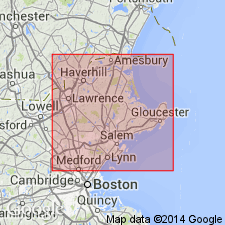
- Usage in publication:
-
- Andover granite
- Modifications:
-
- Original reference
- Dominant lithology:
-
- Granite
- AAPG geologic province:
-
- New England province
Summary:
Andover granite. Normal facies strongly resembles Squam granite. Includes a muscovite granite facies and aplite and pegmatite. [Age is late Carboniferous.]
Source: US geologic names lexicon (USGS Bull. 896, p. 52).
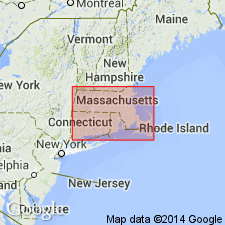
- Usage in publication:
-
- Andover granite*
- Modifications:
-
- Areal extent
- AAPG geologic province:
-
- New England province
Summary:
Pg. 86-87, 220-221, and map. Andover granite. Typically a biotite-muscovite granite of moderately coarse and generally somewhat uneven grain. Generally more or less foliated and in many places strongly gneissic. Parts of it are porphyritic, and aplitic and pegmatitic phases abound. Color ranges from nearly white to dark gray. Composed essentially of feldspar, quartz, muscovite, and biotite. Intrusive, and, with exception of few dikes, the youngest rock in region in which it occurs. Occupies large area around Andover, northern Massachusetts. [Age is late Carboniferous.]
Source: US geologic names lexicon (USGS Bull. 896, p. 52).
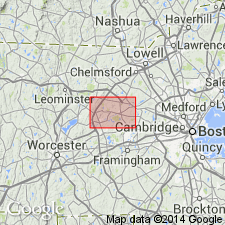
- Usage in publication:
-
- Andover granite*
- Modifications:
-
- Areal extent
- AAPG geologic province:
-
- New England province
Summary:
Pg. 39-40. Andover granite. Term Gospel Hill gneiss proposed for mass of granitic rocks that Emerson (1917) mapped as variant of Andover granite but that is considered in this report [Hudson and Maynard quadrangles] as granitized product of Nashoba (new) and Marlboro formations. [Age is Carboniferous.]
Source: US geologic names lexicon (USGS Bull. 1200, p. 97).
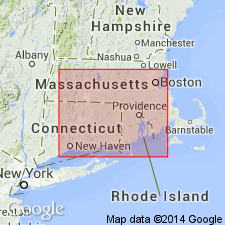
- Usage in publication:
-
- Andover Granite*
- Modifications:
-
- Age modified
- AAPG geologic province:
-
- New England province
Summary:
Age of the Andover Granite changed to Silurian or Ordovician. Age originally was considered to be Carboniferous. Zartman and others (1970) determined that the Andover was Devonian or older. Castle and Theodore (1972) stated that the unit was no younger than Silurian and gave the age as Late Precambrian(?) to Silurian(?).
Source: GNU records (USGS DDS-6; Reston GNULEX).
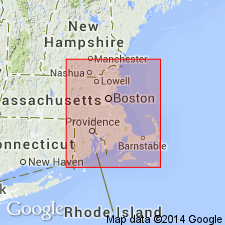
- Usage in publication:
-
- Andover Granite*
- Modifications:
-
- Age modified
- Geochronologic dating
- AAPG geologic province:
-
- New England province
Summary:
Rb-Sr age determinations by R.E. Zartman and R.S. Naylor (written commun., 1981) and by Handford (1965) indicate rocks of more than one age are present in Andover Granite. Masses of undeformed pegmatite and aplite yield Late Silurian or Early Devonian age. Gneissic phase yields Late Ordovician or Early Silurian age. Castle (1965) states that some of Andover is gradational with phases of Sharpners Pond Diorite; if so, Silurian age is indicated for parts of Andover. Until different phases of Andover are sorted out, age is Devonian or Silurian and Ordovician(?).
Source: GNU records (USGS DDS-6; Reston GNULEX).

- Usage in publication:
-
- Andover Granite*
- Modifications:
-
- Overview
- AAPG geologic province:
-
- New England province
Summary:
Used as Andover Granite of Ordovician or Silurian age. Includes Acton Granite. Intrudes Nashoba Formation. [No explanation for age given.]
Source: GNU records (USGS DDS-6; Reston GNULEX).
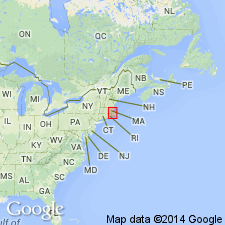
- Usage in publication:
-
- Andover Granite*
- Modifications:
-
- Overview
- Age modified
- Geochronologic dating
- AAPG geologic province:
-
- New England province
Summary:
Andover Granite described as light-colored muscovite- and garnet-bearing, mostly gneissic granite. Includes a nongneissic component that is apparently younger than main mass (Hansen, 1956; Castle, 1964). Includes rocks previously assigned to Acton Granite of Hansen (1956) that probably belong to Andover's older phase. Text of report states that gneissic granite is dated at 450 to 445 Ma; younger phase of granite and pegmatite is dated at 415 to 410 Ma. Table 13 reports Rb-Sr whole rock ages of 446 +/-32 Ma (Zartman and Naylor, 1984), 450 +/-23 Ma (Handford and others, 1965), and 460 Ma (Schutts and others, 1976) for the older phase. Rb-Sr whole-rock ages for the younger phase are reported as 408 +/-22 Ma (Zartman and Naylor, 1984), and 415 Ma (Hill and others, 1984). Age in report is Ordovician and Silurian. [Papers presented as chapters in U.S. Geological Survey Professional Paper 1366 are intended as explanations and (or) revisions to Massachusetts State bedrock geologic map of Zen and others (1983) at scale of 1:250,000.]
Source: GNU records (USGS DDS-6; Reston GNULEX).
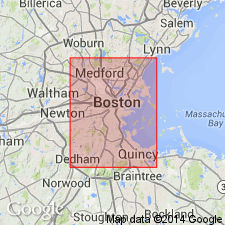
- Usage in publication:
-
- Andover Granite
- Modifications:
-
- Geochronologic dating
- AAPG geologic province:
-
- New England province
Summary:
Date of 412 +/-2 Ma on monazite from the Andover Granite supports the age for the younger phase of this complex pluton. Date also confirms the Silurian timing of the deformation and metamorphism in the terrane and supports the theory that the peralumninous Andover was at least partially generated by anatexis of sediments of the Nashoba Formation.
Source: GNU records (USGS DDS-6; Reston GNULEX).
For more information, please contact Nancy Stamm, Geologic Names Committee Secretary.
Asterisk (*) indicates published by U.S. Geological Survey authors.
"No current usage" (†) implies that a name has been abandoned or has fallen into disuse. Former usage and, if known, replacement name given in parentheses ( ).
Slash (/) indicates name conflicts with nomenclatural guidelines (CSN, 1933; ACSN, 1961, 1970; NACSN, 1983, 2005, 2021). May be explained within brackets ([ ]).

